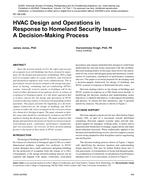Description
Since the terrorist attacks on 911 the safety and security of occupants in at-risk buildings has been elevated in importance for the design and operations of buildings. With a high level of occupant safety as a goal, architects, and structural and mechanical engineers must work collaboratively. This is particularly true for decisions related to the design and operation of heating, ventilating and air-conditioning (HVAC) systems. Generally terrorist attacks on buildings will be the result of either detonation of an explosive devise or release of a chemical or biological agent. It is this latter approach that is of most concern for the design and operations of HVAC systems as they may reduce or increase risk depending on their operation. This paper presents the beginning of a decisionsupport framework for the design of buildings and HVAC systems to reduce the risk to occupants in the event of a release of a chemical or biological agent. The paper attempts to identify issues that should be considered by architects and HVAC engineers during the design process. The paper proposes that design and operations decisions are based on risk assessment, owner/design goals, constraints, performance satisfaction, and cost assessment. An overview of these decision-making factors is discussed as they relate to HVAC systems.
Units: Dual
Citation: ASHRAE Transactions, vol. 114, pt. 1, New York 2008
Product Details
- Published:
- 2008
- Number of Pages:
- 7
- File Size:
- 1 file , 1.3 MB
- Product Code(s):
- D-NY-08-048




